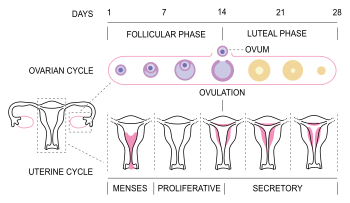Cycle Tracking (also called Ovulation Tracking)
Cycle tracking involves determining the time of ovulation so that intercourse can occur at the optimal time for fertilisation of the released ovum. Cycle tracking is also very useful as a diagnostic tool.
Ovulation is the release of a mature oocyte (eggs) from the ovary. Usually only one oocyte is released per month. Oocytes are found in the ovaries in a very immature form and are not capable of being fertilised by a sperm. At the time of ovulation, they undergo a maturing process which culminates in their release from the ovary. Ovulation may be detected by: Fertility clinics use a combination of hormone blood tests and ultrasound/s to monitor when ovulation is likely to occur. Together the tests provide strong evidence that ovulation will occur. A series of blood tests to monitor the levels of oestrogen, LH, Progesterone and FSH are used to monitor the cycle and predict ovulation. These blood tests usually start on day 8 of the cycle (ie 8 days after the start of menstruation). After the first blood test the patient will be told when she needs to have the next test. When the results of a blood test indicate that ovulation is likely, (and the ultrasound results also support this) the patient will be informed of the optimal time for intercourse in order to conceive. The female sex hormone oestrogen(oestradiol) is produced by the cells surrounding a maturing oocyte within the ovary. As the oocyte matures more oestrogen is produced, reaching a peak level about two days before ovulation. If more than one oocyte matures simultaneously, the oestrogen produced by the ovary is greatly increased. Oestrogen levels can be measured in blood tests and its effects on the body are usually obvious, particularly on the amount and consistency of mucous discharged from the vagina. As the oestrogen level increases, the amount of mucous increases. This mucous is stringy and has the appearance and consistency of raw egg white. The maturation of oocytes and ovulation is stimulated by two hormones secreted by the pituitary, a gland at the base of the brain, follicle stimulating hormone (FSH) and luteinising hormone (LH). It is important these two hormones are produced in appropriate amounts throughout the monthly cycle for normal ovulation to occur. Ovulation is triggered by a surge of luteinising hormone (LH) from the pituitary gland. LH also stimulates the ovary to begin producing the hormone progesterone. Progesterone is only produced in significant amounts after ovulation has occurred and can be measured in the blood. Progesterone changes the consistency of the vaginal mucous so that it becomes tacky or sticky. This hormone also causes a slight increase in body temperature. Progesterone pessaries are often used to maintain the endometrium after ovulation, and may need to be continued, often for the first trimester of a pregnancy. As the oocyte matures a cyst called a follicle develops on the ovary. This follicle, which can be seen and measured on an ultrasound picture of the ovaries, may grow to about 2cm in diameter just before ovulation. The development of the endometrium is another way of detecting ovulation. The development of the endometrium is monitored by ultrasound scanning (approximately 1–2 scans). The first ultrasound is usually performed on day 10-12 of the cycle (ie 10 to 12 days after the start of menstruation). If an ultrasound shows that the follicle has developed to a large enough size and that the endometrium is thick enough and of the right maturity, this indicates that ovulation is likely to occur. The results of the ultrasound and blood tests are used together to indicate the timing of ovulation. Ovulation usually occurs regularly, once a month from puberty until the menopause, except during times of pregnancy and sometimes breast-feeding. In some women ovulation does not occur regularly, or may not occur spontaneously at all. This may be due to an abnormality with the ovaries, the pituitary gland or some other unrelated illness such as anorexia. A number of tests are necessary to determine the cause of this situation before appropriate treatment can be given.
Blood testing for hormones: Oestrogen, LH, Progesterone and FSH

Ultrasound testing for ovulation
Irregular Cylces

